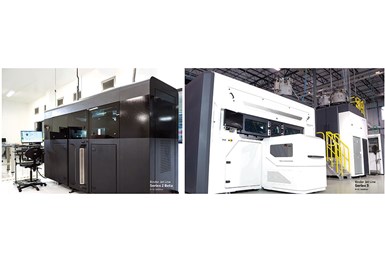Kennametal Joins GE Additive Beta Partner Program
As part of the program, Kennametal will work with GE Additive to identify, design and scale specific applications for serial production on GE’s binder Jet system to leverage its cemented tungsten carbide additive materials.

The evolution of GE Additive’s binder jet technology shown with Series 2 (left) and Series 3 (right). Photo Credit: GE Additive
Kennametal is the latest member to join GE Additive’s Beta Partner Program. As part of the program, Kennametal will work to further advance its binder jet printing capabilities in cemented tungsten carbide as it continues to scale its end-to-end metal additive manufacturing (AM) solutions from metal powders through to the production of 3D printed parts and tooling.
According to the company, Kennametal’s metal 3D printed parts have already gained wide customer adoption across a variety of industries, including oil and gas, energy, industrial processing and transportation. Kennametal will work with GE Additive to identify, design and scale specific applications for serial production on GE’s binder Jet system to leverage Kennametal’s proprietary cemented tungsten carbide additive materials.
Kennametal is a provider of tungsten carbide and Stellite (cobalt chrome alloy) alloys, which it says are known for their wear, heat and corrosion performance. The company says it is focused on optimizing these high-performance, wear- and corrosion-resistant material families for additive platforms to produce fully finished components with complex designs, shorter lead times and improved performance which are not possible through traditional manufacturing. When combined with AM, these proprietary material systems are said to offer a step change in wear and corrosion solutions for some of the most challenging applications.
“Customers are increasingly seeking our 3D printed tungsten carbide and Stellite solutions to help them maximize their productivity in challenging applications when wear and corrosion resistance are critical,” says Jay Verellen, general manager, Kennametal Additive Manufacturing. “Our work with GE Additive on binder Jet solutions will enable further scaling of our operations to meet strong customer demand — and extend our leadership in proprietary material solutions for additive.”
GE Additive says it is continuing to develop its binder jet solution to make AM a reality for serial production, targeting millions of parts per year and beyond. Key to that development is ongoing, hands-on input from members of GE Additive’s Binder Jet Beta Partner Program.
“By hands-on, we don’t mean tinkering or experimenting. We work closely with our beta customers as they develop their own, real-world business cases, applications and parts,” says Brian Birkmeyer, GE Additive’s product line leader for binder jet. “To them, it is important that our solution is not only mature and scalable but is capable, complete and aligns to their product innovation strategies and meets production volume needs.”
Related Content
-
ActivArmor Casts and Splints Are Shifting to Point-of-Care 3D Printing
ActivArmor offers individualized, 3D printed casts and splints for various diagnoses. The company is in the process of shifting to point-of-care printing and aims to promote positive healing outcomes and improved hygienics with customized support devices.
-
Beehive Industries Is Going Big on Small-Scale Engines Made Through Additive Manufacturing
Backed by decades of experience in both aviation and additive, the company is now laser-focused on a single goal: developing, proving and scaling production of engines providing 5,000 lbs of thrust or less.
-
At General Atomics, Do Unmanned Aerial Systems Reveal the Future of Aircraft Manufacturing?
The maker of the Predator and SkyGuardian remote aircraft can implement additive manufacturing more rapidly and widely than the makers of other types of planes. The role of 3D printing in current and future UAS components hints at how far AM can go to save cost and time in aircraft production and design.














